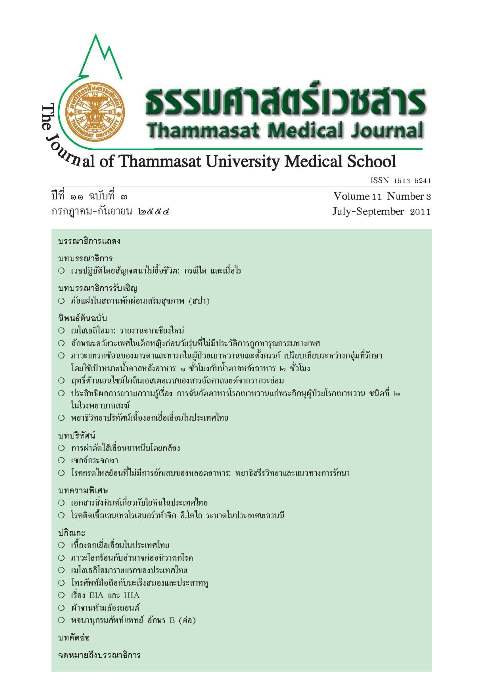Maternal and neonatal complication comparing between one-hour versus two-hour postprandial glycemic target in gestational diabetic subjects
Keywords:
เบาหวานในการตั้งครรภ์, ภาวะแทรกซ้อน, ระดับน้ำตาลหลังอาหาร, Gestational Diabetes Mellitus, Complication, Postprandial glycemicAbstract
Introduction: Gestational Diabetes Mellitus (GDM) causes maternal and fetal complications. It is treated by diet control or insulin injections. Monitoring of treatment is to check sugar levels, which can be checked at 1 or 2 hours after meals. However, there is not sufficient evidence regarding the appropriate time for follow up and monitoring the maternal and fetal complications. This study aimed to compare the incidence of major complications in mothers and infants in the group treated with the target blood glucose level at 1 hour or 2 hours after meals.
Method: The study designed as prospective study. 106 pregnant women who met the criteria of GDMwere considered for screening and inclusion. GDM patient’s were divided into to 2 group, 1st group is 1 hour postprandial capillary glucose monitoring (n = 26). 2nd group 2 hours is postprandial capillary glucose monitoring (n = 20). All of them and evaluation, treatment, dietary, advice and follow up with the internist, endocrinologist, obstetric-gynecologist and diabetic advisor team. Progression of sugar level, level of Insulin using, gestational age, ultrasound, gestational time of labor and mode of labor, and materno-fetal complication were recorded.
Result: Mean age of patients was 33.43 ± 4.90 years. Mean gestational weeks of diagnosis GDM were 24 ± 5 Weeks. Mean postprandial sugar levels of both groups were 126.15 ± 9.33 mg/dL (1st group) and 111.25 ± 11.19 mg/dL (2nd group). The results showed no significant difference when comparing two groups in the amount of insulin usage 0.13 ± 0.17 unit/kg. (1st group) and 0.14 ± 0.21 unit/kg. (2nd group); (p = 0.39), gestational age at delivery 37.06 ± 1.53 weeks (1st group) and 38.24 ± 0.77 weeks (2nd group); (p = 0.09), rate of caesarean section 71% (1st group) and 61.90% (2nd group); (p = 0.30), fetal weight 3,038.80 ± 640.52 gm (1st group) and 2,961.90 ± 463.44 gm (2nd group); (p = 0.69). There is no significant difference in the outcome. Maternal complications were 8% (1st group) and 10% (2nd group); (p = 0.86). Fetal complications were 24% (1st group) and 5% (2nd group); (p =0.07).
Conclusion: Patients with GDM who monitored postprandial glycemic monitoring 1 or 2 hours had no significant difference in terms of rate of insulin usage, amount of insulin, gestational age at birth, rate of cesarean section, fetal birth weight, maternal complications and fetal complications.
Key words: Gestational Diabetes Mellitus, Complication, Postprandial glycemic


